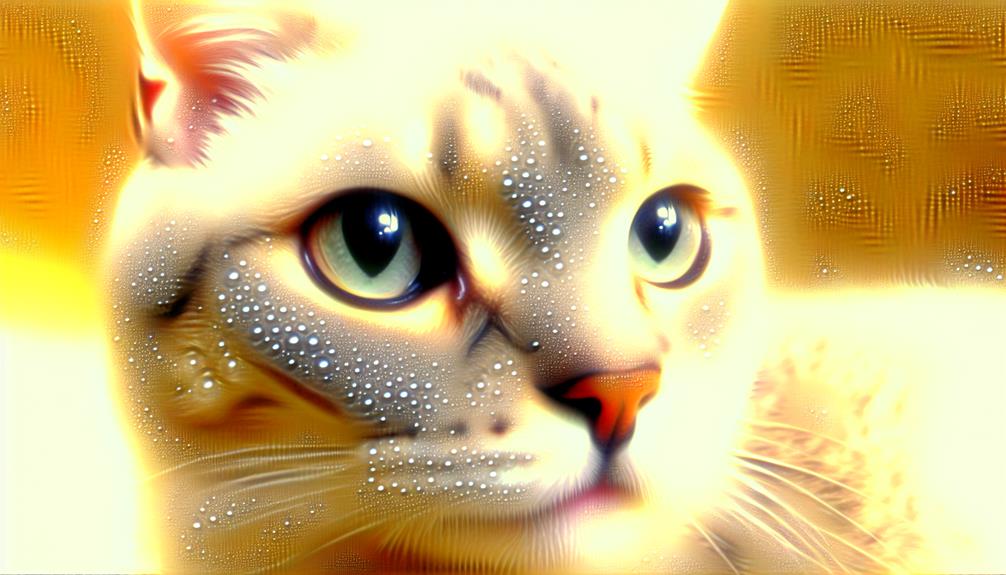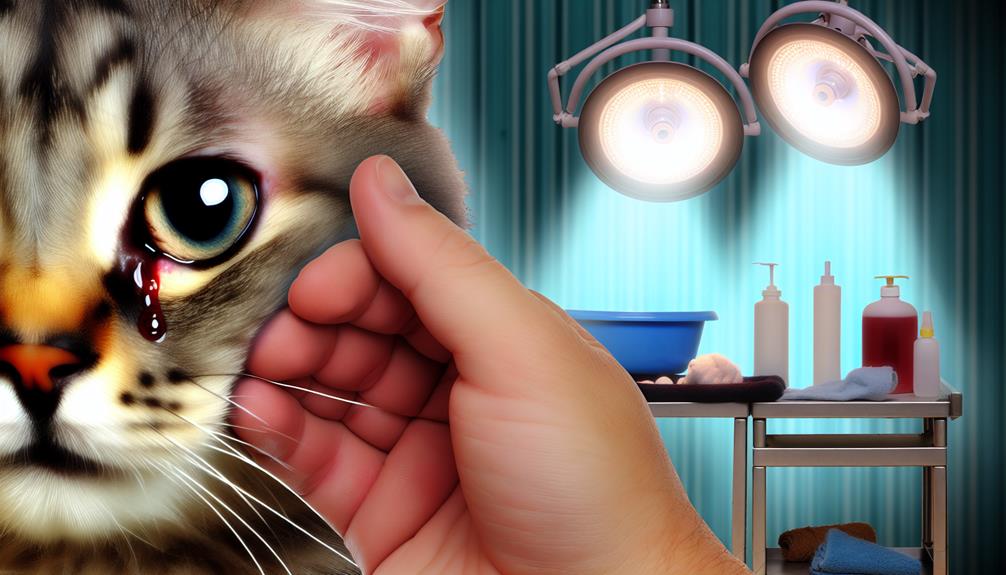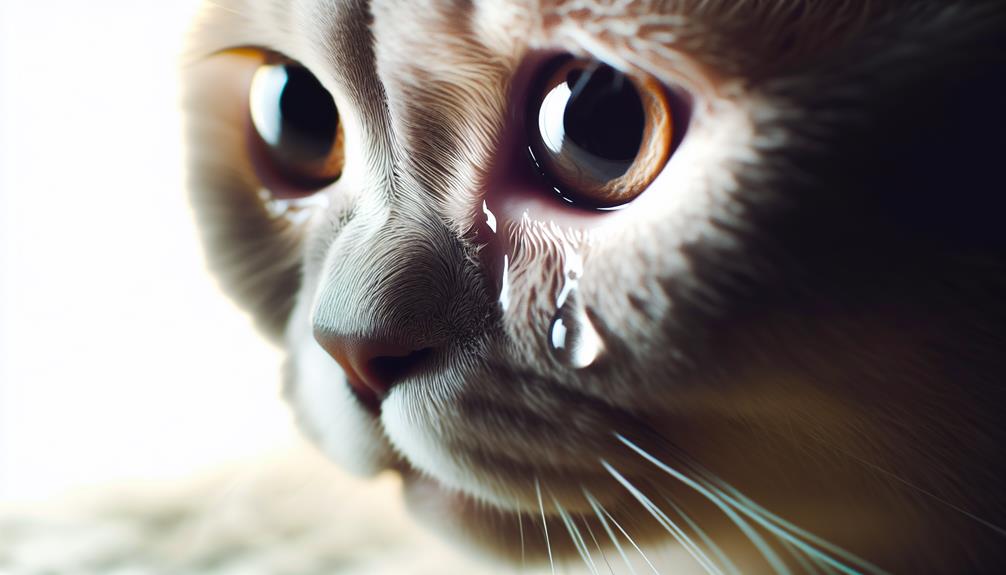Have you ever wondered if your cat can cry like humans do? It's a fascinating topic because, while cats don't shed tears out of emotional sadness, they do have other ways of showing distress. You might notice watery eyes or hear more vocalizations when they're upset. But what does it really mean when your cat's eyes are tearing up? Could it be an emotional expression or something else entirely? Let's explore the reasons behind those watery eyes and how to truly understand your feline friend's emotions.
Feline Tear Production
Feline tear production, an important aspect of ocular health, involves the secretion of tears by the lacrimal glands located near the eyes. In understanding this process, it's vital to examine both the physiological mechanisms and the relevant structures within feline anatomy.
The lacrimal glands, situated dorsolaterally to each eye, are responsible for the production of the aqueous component of tears. These tears serve to lubricate the cornea, facilitate the removal of debris, and provide antimicrobial protection. Once produced, tears travel through a network of tear ducts. These ducts, specifically the nasolacrimal ducts, channel the tears from the ocular surface to the nasal cavity, ensuring a continuous flow and preventing the accumulation of excess fluid on the eye's surface.
In feline anatomy, the tear production process is finely regulated. The lacrimal glands respond to various stimuli, including environmental factors and potential irritants. When the eye is exposed to dust or other particulate matter, the glands increase tear production to flush out the irritants. This response is mediated through both autonomic nervous system controls and reflexive actions, demonstrating the complexity of feline tear regulation.
It's important to note that any obstruction in the tear ducts can lead to conditions such as epiphora, where tears overflow onto the face. This could be due to congenital malformations, infections, or trauma. Understanding the anatomy and physiology of feline tear production is significant for diagnosing and treating such conditions effectively.
Emotional Expressions in Cats
Understanding emotional expressions in cats requires a nuanced approach to their behavioral cues and physiological responses. Cats don't cry like humans, but their emotions manifest through specific behaviors and physical signals. Key indicators include purring patterns, tail language, vocalizations, and body posture.
Purring is often associated with contentment, but it can also signify stress or pain. Different purring patterns can provide insights into your cat's emotional state. A steady, rhythmic purr usually indicates relaxation, whereas an irregular or high-pitched purr might suggest discomfort or anxiety. Tail language is another critical aspect. A cat's tail position and movement offer valuable information about its feelings. For instance, a tail held high generally signifies confidence, while a puffed-up tail indicates fear or agitation.
Here's a concise table to help you decode your cat's emotions:
| Behavioral Cue | Likely Emotional State |
|---|---|
| Steady, rhythmic purr | Relaxation, Contentment |
| Irregular purr | Stress, Discomfort |
| Tail held high | Confidence, Happiness |
| Puffed-up tail | Fear, Agitation |
Vocalizations also play a significant role. Cats can produce a variety of sounds, each with different meanings. A short, high-pitched meow might signal a greeting, while a prolonged, low-pitched meow could indicate unhappiness or a demand for attention. Additionally, body posture, such as crouching or arching the back, can provide further clues.
Physical Causes of Watery Eyes

When observing your cat's eyes, you might notice excessive tearing, which can stem from a variety of physical causes. One common cause is allergies. Various environmental triggers, such as pollen, dust, or certain chemicals, can initiate an allergic response in your cat, leading to watery eyes. This reaction is a defense mechanism designed to flush out irritants from the eye surface.
Another significant cause of watery eyes in cats is eye infections. Bacterial, viral, or fungal pathogens can invade the eye, causing inflammation and increased tear production. Symptoms often include redness, swelling, and discharge, which necessitate prompt veterinary attention to prevent more severe complications.
Furthermore, certain anatomical issues can also result in excessive tearing. Some cat breeds have congenital conditions like entropion, where the eyelid rolls inward, causing the eyelashes to irritate the cornea. This can lead to chronic tearing and discomfort.
Here are three key physical causes of watery eyes in cats:
- Allergies: Environmental triggers like pollen, dust, or chemicals.
- Eye Infections: Bacterial, viral, or fungal pathogens causing inflammation.
- Anatomical Issues: Conditions like entropion causing eyelid and eyelash irritation.
Understanding these physical causes can help you identify the root of your cat's watery eyes and seek appropriate treatment. If your cat's eyes are persistently watery, it's essential to consult a veterinarian for a thorough examination and accurate diagnosis. Addressing the underlying issue promptly can prevent further discomfort and maintain your cat's overall eye health.
Signs of Sadness in Cats
When identifying signs of sadness in cats, you'll observe notable behavioral changes such as increased isolation or decreased interest in activities they once enjoyed. Additionally, physical symptoms like reduced appetite, excessive grooming, or changes in vocalization can indicate emotional distress. Recognizing these signs is essential for addressing the underlying causes and providing appropriate care.
Behavioral Changes Noticed
Observing changes in your cat's behavior can be critical in identifying signs of sadness. One of the primary indicators is alterations in cat vocalizations. If your cat suddenly becomes more vocal or, conversely, unusually silent, this shift can signal emotional distress. Stress indicators, such as excessive grooming or refusal to groom, are also notable. An anxious or sad cat may overgroom to the point of creating bald patches or, alternatively, neglect its hygiene entirely.
Behavioral changes are multifaceted, and recognizing them requires careful attention:
- Changes in social interactions: If your cat, once social, begins to isolate itself or hide more frequently, this can indicate sadness.
- Altered eating habits: A decline in appetite or disinterest in food can be a significant red flag. Conversely, some cats might overeat as a coping mechanism.
- Lethargy or decreased activity: Reduced playfulness or reluctance to engage in activities they once enjoyed can suggest emotional distress.
These behavioral changes are critical for understanding your cat's emotional state. Monitoring these signs allows you to intervene appropriately, ensuring your pet's well-being. Remember, behavioral shifts can be subtle yet significant markers of a deeper issue.
Physical Symptoms Observed
Spotting physical symptoms of sadness in cats can be vital for their well-being. Understanding cat anatomy helps in identifying signs that might indicate emotional distress. One such sign is the presence of tear production, though it's important to recognize that unlike humans, cats don't cry emotional tears. Their tear ducts serve primarily to lubricate the eyes and remove debris.
You might notice an increase in tear production, which can manifest as watery eyes. This could be due to blocked tear ducts or an underlying health issue, such as an infection or allergy, rather than sadness. Additionally, be vigilant for changes in grooming habits. Cats experiencing emotional distress might groom excessively or, conversely, neglect grooming altogether, leading to matted fur or skin issues.
Physical symptoms of sadness can also include alterations in appetite. A sad cat might eat less or more than usual, impacting their weight and overall health. You should also observe for lethargy or decreased activity levels. Cats in emotional distress might withdraw, hiding more often or showing less interest in play and interaction.
Identifying these physical symptoms allows you to address potential emotional or health issues promptly, ensuring your cat's well-being.
Health Issues Affecting Eyes

Although cats are known for their keen vision, various health issues can affect their eyes, potentially leading to discomfort or more severe problems. One common issue is eye infections, which can arise from bacteria, viruses, or fungi. These infections often cause symptoms such as redness, swelling, discharge, and excessive tearing. If left untreated, eye infections can lead to more serious complications, including corneal ulcers or even vision loss.
Another prevalent issue is tear duct obstruction. This condition occurs when the tear ducts are blocked, preventing tears from draining properly. As a result, tears overflow onto the face, leading to wet fur and an increased risk of secondary infections. Tear duct obstruction can be congenital or acquired through injury or inflammation. Diagnosing this condition typically involves a fluorescein dye test to observe tear drainage.
Additionally, cats can suffer from other ocular conditions such as:
- Conjunctivitis: Inflammation of the conjunctiva, often caused by infections or allergies, leading to red, swollen eyes and discharge.
- Glaucoma: Increased intraocular pressure damaging the optic nerve, which can cause pain and potential blindness if untreated.
- Cataracts: Opacity of the lens, often age-related, hindering vision and potentially leading to complete blindness.
To guarantee your cat's ocular health, it's essential to monitor for any signs of eye discomfort or abnormalities. Regular veterinary check-ups can help diagnose and treat these conditions early, mitigating the risk of long-term damage. If your cat exhibits symptoms of eye infections or tear duct obstruction, seek veterinary care promptly to safeguard their vision and overall well-being.
Understanding Your Cat's Emotions
While maintaining your cat's ocular health is essential, understanding their emotions plays an equally important role in ensuring their overall well-being. Cats may not cry tears due to emotional distress, but they do exhibit a range of behaviors and body language that convey their feelings. Recognizing these signs is vital for effective cat communication.
Cats use a combination of vocalizations, postures, and facial expressions to communicate. Feline body language can be subtle, and mastering its nuances will help you respond appropriately to your cat's emotional states.
Key Indicators of Cat Emotions
| Behavior/Sign | Emotion Indicated |
|---|---|
| Purring | Contentment, relaxation |
| Hissing or growling | Fear, aggression |
| Slow blinking | Trust, affection |
| Tail upright and quivering | Excitement, happiness |
| Flattened ears | Anxiety, fear |
Purring typically indicates contentment and relaxation, though it can also occur when a cat is in pain. Hissing or growling signifies fear or aggression, suggesting your cat feels threatened. When a cat gives you slow blinks, it's a sign of trust and affection. An upright, quivering tail often denotes excitement and happiness, while flattened ears are a clear indication of anxiety or fear.
Understanding these behaviors allows you to cater to your cat's needs more effectively. For instance, if your cat displays signs of anxiety, creating a safe and calm environment can alleviate their stress. Conversely, recognizing when your cat is happy enables you to reinforce positive behaviors.
Conclusion
In conclusion, while cats don't cry due to emotions, they do produce tears from physical discomfort. Imagine your cat, Whiskers, suddenly having watery eyes and scratching at them frequently. This behavior could indicate an underlying issue like an eye infection or allergies, necessitating a vet visit. Recognizing the difference between emotional and physical expressions in cats guarantees timely medical intervention, maintaining your feline's health and emotional well-being. Always stay observant and responsive to your cat's behavior.
